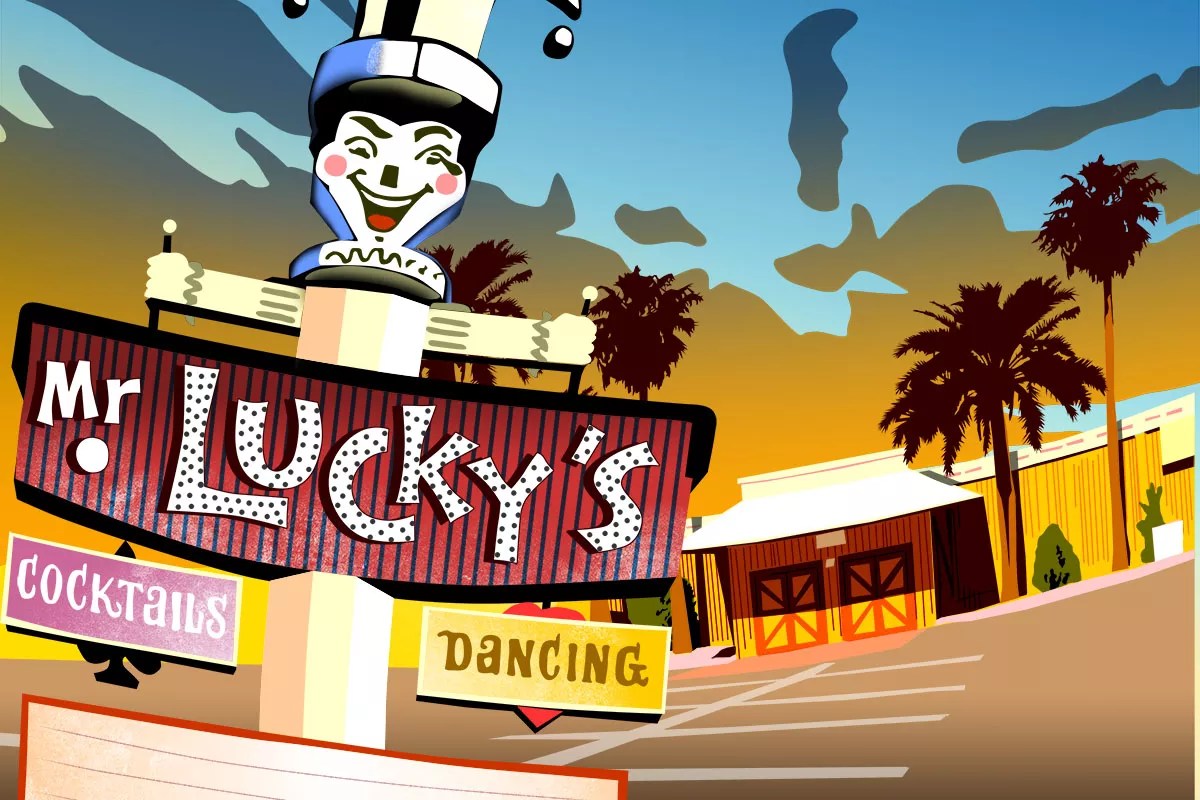
Tom Carlson

Audio By Carbonatix
J.David Sloan sure plays a mean fiddle. The 79-year-old country musician wails on the stringed instrument tucked underneath his chin as his backing band Western Bred unleashes a rip-roaring cover of George Jones’ “White Lightning” on an outdoor stage at Roadrunner Restaurant and Saloon in New River. Clad in a white Western shirt, blue jeans, and a black cowboy hat, his hands and arms are a flurry of motion as he saws at the strings with his bow in one hand and works the fingerboard with the other. He steps to a microphone and sings the lyrics to the Jones’ ode to moonshine.
Sloan and Western Bred are the headlining act at a 55th-anniversary reunion party for Mr. Lucky’s, the iconic Phoenix nightclub and honky-tonk he performed at and later owned. More than 2,000 people have come to the Roadrunner for the event, a lively party with plenty of hootin’ and hollerin’.
The event is not unlike an average night at Mr. Lucky’s, which operated for 38 years at Grand and 36th avenues. Cowboys and cowgirls are spinning, dipping, and two-stepping around a parquet dance floor. Riders hang onto enormous bucking bulls in an outdoor rodeo arena nearby. There’s even a scale mock-up of Mr. Lucky’s iconic sign.
Opened in early October 1966 by entrepreneur and restaurateur Bob Sikora, the double-decker nightclub had country music in its main room, with rock bands and pop artists performing on a rotating stage in the basement. Outside, its towering 50-foot-tall sign – depicting a jester-like harlequin drenched with neon and twinkling bulbs – beckoned in the public.
Phoenix, make your New Year’s Resolution Count!
We’re $11,000 away from reaching our $30,000 year-end fundraising goal. Your support could be what pushes us over the top. If our work has kept you informed, helped you understand a complex issue, or better connected you to your community, please consider making a contribution today.
Country became Mr. Lucky’s true calling, as Sikora brought in big names for his “guest star” nights. Willie and Waylon. Cash and Campbell. Wanda Jackson recorded a 1969 live album at Mr. Lucky’s and featured its sign on the cover. African-American country singer Charley Pride became a fixture after being snubbed by Scottsdale clubs. Its longtime house band, The Rogues, featured a rotating lineup of some of the best country musicians in the Valley, including singers like Virg Warner and Sloan.
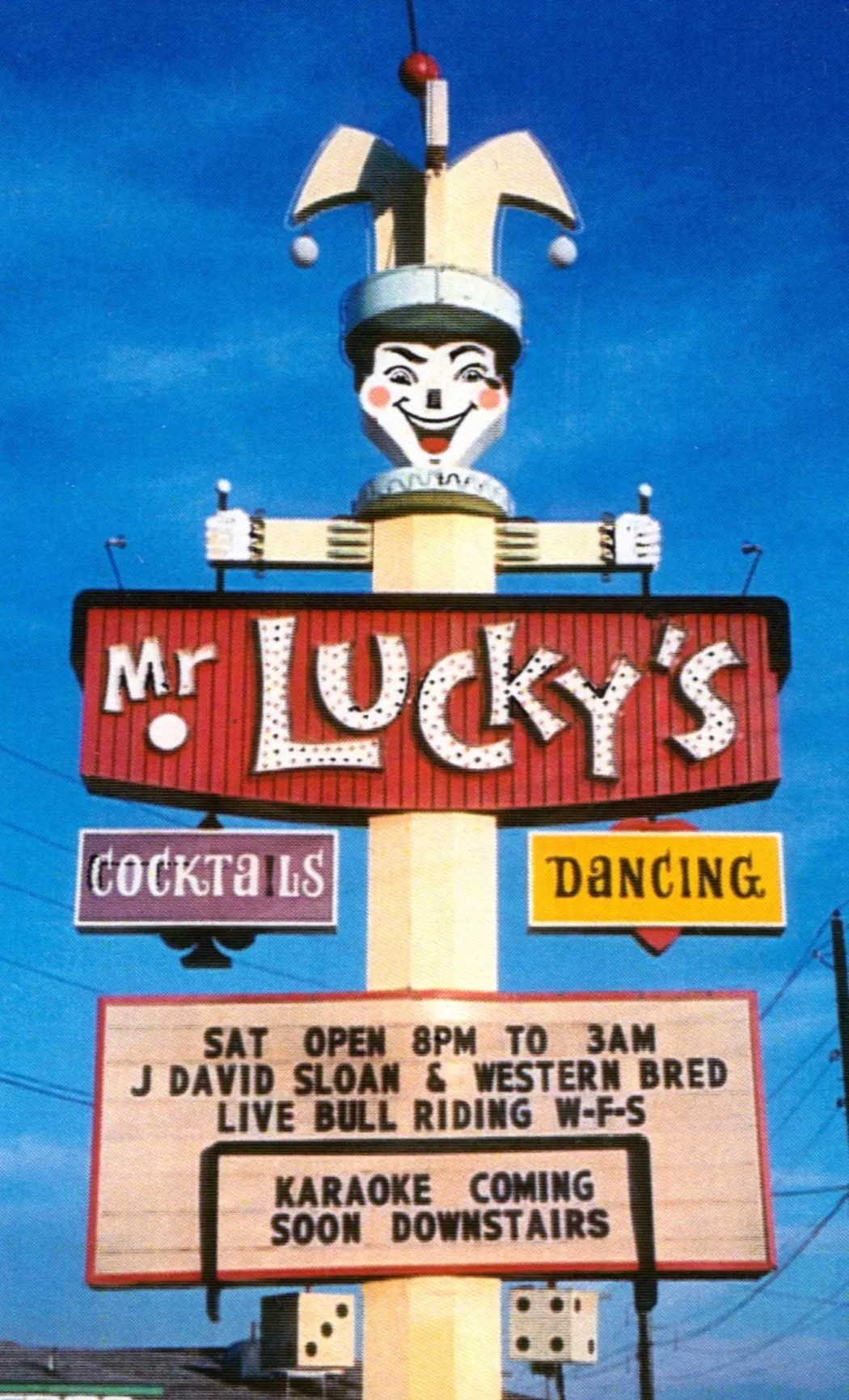
Mr. Lucky’s iconic sign in the early 1990s.
Douglas Towne
Mr. Lucky’s got even bigger in the ’80s, thanks to the Urban Cowboy-fueled country craze and an appearance on a Waylon Jennings television special. It became the first bar in Arizona to offer live bull-riding when Sloan, who purchased the club from Sikora, added an outdoor rodeo in the ’90s. (Its family-friendly Friday night fish fry and kids’ night talent contests were also popular with its die-hard group of loyal regulars.) “Mr. Lucky’s over the years was the gold standard of country nightclubs in Phoenix,” says former KNIX and KMLE on-air personality Jim West. “It was very, very popular and everyone wanted to go there.”
Besides setting the example for local honky-tonks, Mr. Lucky’s helped shape the careers of a few future superstars. Members of house band The Rogues helped Lyle Lovett land his first major-label deal. Jordin Sparks got vocal coaching and recording tips from Sloan years before winning American Idol.
Mr. Lucky’s rode into the sunset in 2004 after Sloan closed its double doors and sought greener pastures. In the 17 years since, the club’s legend has only grown as it entered local lore.
Its onetime resident musicians from The Rogues have won Grammys and become in-demand producers and session musicians for country superstars. Former regulars flock to reunion events or trade memories on a Facebook group dedicated to the club. Historic preservationists and culture aficionados clamor for someone to restore the place, which has fallen into serious disrepair, or fret over the future of its iconic sign.
“That’s all people ever talk about anymore,” Sloan says. Phoenix New Times has heard plenty about Mr. Lucky’s famous sign lately. In tribute to the club, which opened 55 years ago this month, we’ve lassoed together a collection of tall tales and wild yarns of big shows and good times from its musicians, employees, and loyal regulars for an oral history of the place. Y’all check it out.
In the early 1960s, entrepreneur Bob Sikora saw some success opening or buying local restaurants, then flipping them. He eventually expanded to nightclubs.
Bob Sikora, original owner of Mr. Lucky’s: My very first nightclub was Jeb’s on West Indian School Road. It was actually a restaurant club. Sort of a joint. Breakfast, lunch, and dinner, and I came back at nine o’clock and opened the place up for a nightclub till one in the morning. From there I opened a place called Magoo’s at 19th Avenue and Van Buren, a country [music] club. That was ’64. Then I sold it.
Sikora had saved enough money by 1966 for something bigger and more ambitious: a 19,000-square-foot, two-story nightclub called Mr. Lucky’s. Partnering with the late George Xericos, a friend and fellow entrepreneur, Sikora searched the west Valley for an ideal location before going with a spot at Grand Avenue just northwest of 35th Avenue and Indian School.
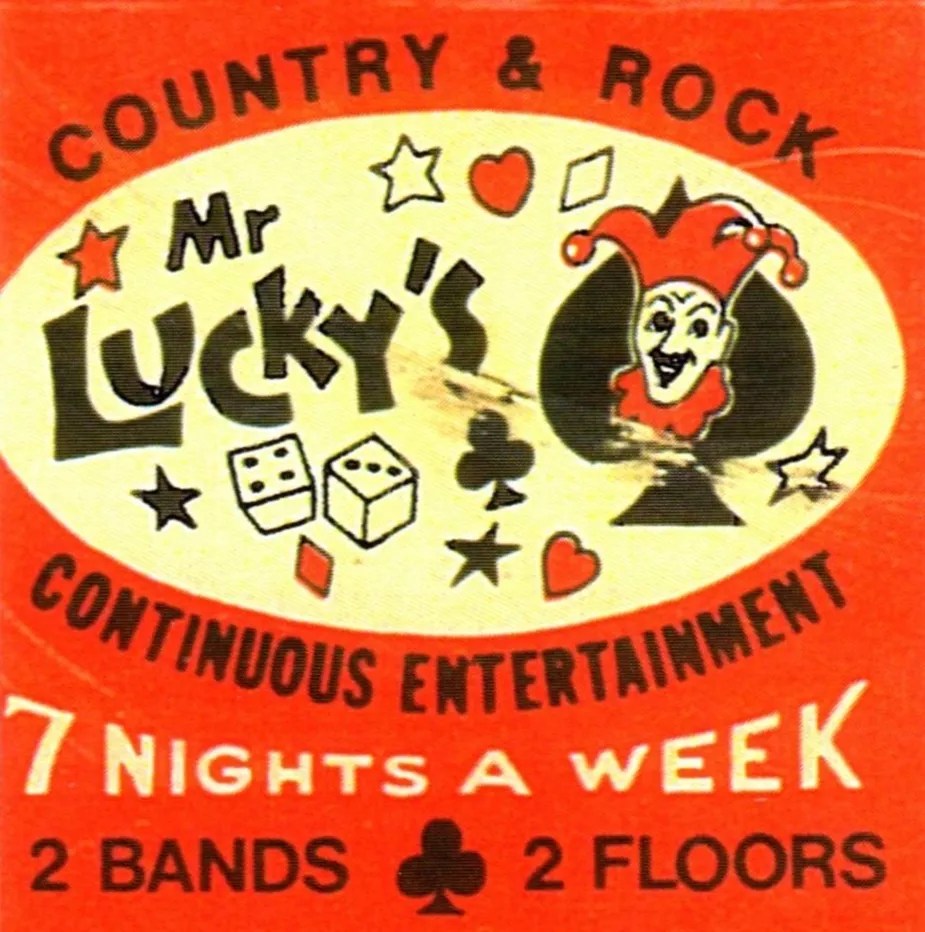
Artwork from an early Mr. Lucky’s matchbook.
Douglas Towne
Sikora: We both wanted to do a huge nightclub that had a downstairs and upstairs. Downstairs would be rock and upstairs would be country.
Jim West, music historian and former on-air talent, KNIX: There were several smaller clubs in the early-to-mid ’60s like Satin Doll with just a bandstand in the corner that played country. Mr. Lucky’s happened to be the first big, big nightclub in the west Valley.
John Dixon, music historian: There was JD’s in Tempe, which was similar: a [two-floor] club with country and rock. [Mr. Lucky’s] survived and stuck around for decades, whereas JD’s didn’t.
Sikora: The west side was cheap at the time. The [property] owner was a gentleman we found that would do a build-to-suit.
Mr. Lucky’s reportedly cost $200,000 to build, $12,000 of which went toward the creation of its iconic sign, made by the now-defunct Myers & Leiber Neon Sign Company. Famed designer Glen Guyette was the art director there.
Glen Guyette, retired designer: George Xericos was one of our neighbors, and our kids and their kids ran around together. He had a little cafe, then, all of a sudden, he was a club owner and was running Mr. Lucky’s. I worked for Myers & Leiber then [and] they got Mr. Lucky’s sign because I knew George and had done a sign for his cafe.
Mr. Lucky’s debuted in early October 1966. Sikora says there were snafus on opening night.
Sikora: On this revolving stage downstairs, I had go-go girls on one side and a band on the other. And it broke down, so I was down there pushing it around myself. It did that two nights in a row. Finally, we got it fixed and it stayed until I put a bandstand against the wall.
The Rogues, led by singer Virg Warner, kicked off their lengthy run as Mr. Lucky’s country house band. House rock band Steph and Themselves performed downstairs.
Sikora: Virg Warner was the best country singer in the state at the time. My downstairs house band was the best rock ‘n’ roll band in the state. I brought down guest stars every Thursday night. We had crowds right from the start. People heard about us and were curious.
Dixon: Sikora knew how to promote and was very, very good at it.
In 1967, Sikora bought out George Xericos because of friction between the two. Xericos went to Denver and opened a Mr. Lucky’s there. The Phoenix club continued to grow. In January 1969, a show at Mr. Lucky’s by groundbreaking African-American country artist Charley Pride made headlines in the Arizona Republic for its enormous turnout. (Sikora reportedly turned 1,000 people away).
Sikora: He wanted to get booked in Scottsdale and they turned him down because he was African-American. [His people] called me and I said, “Come on over.” He had been on the road a little, but I had him there from then on.
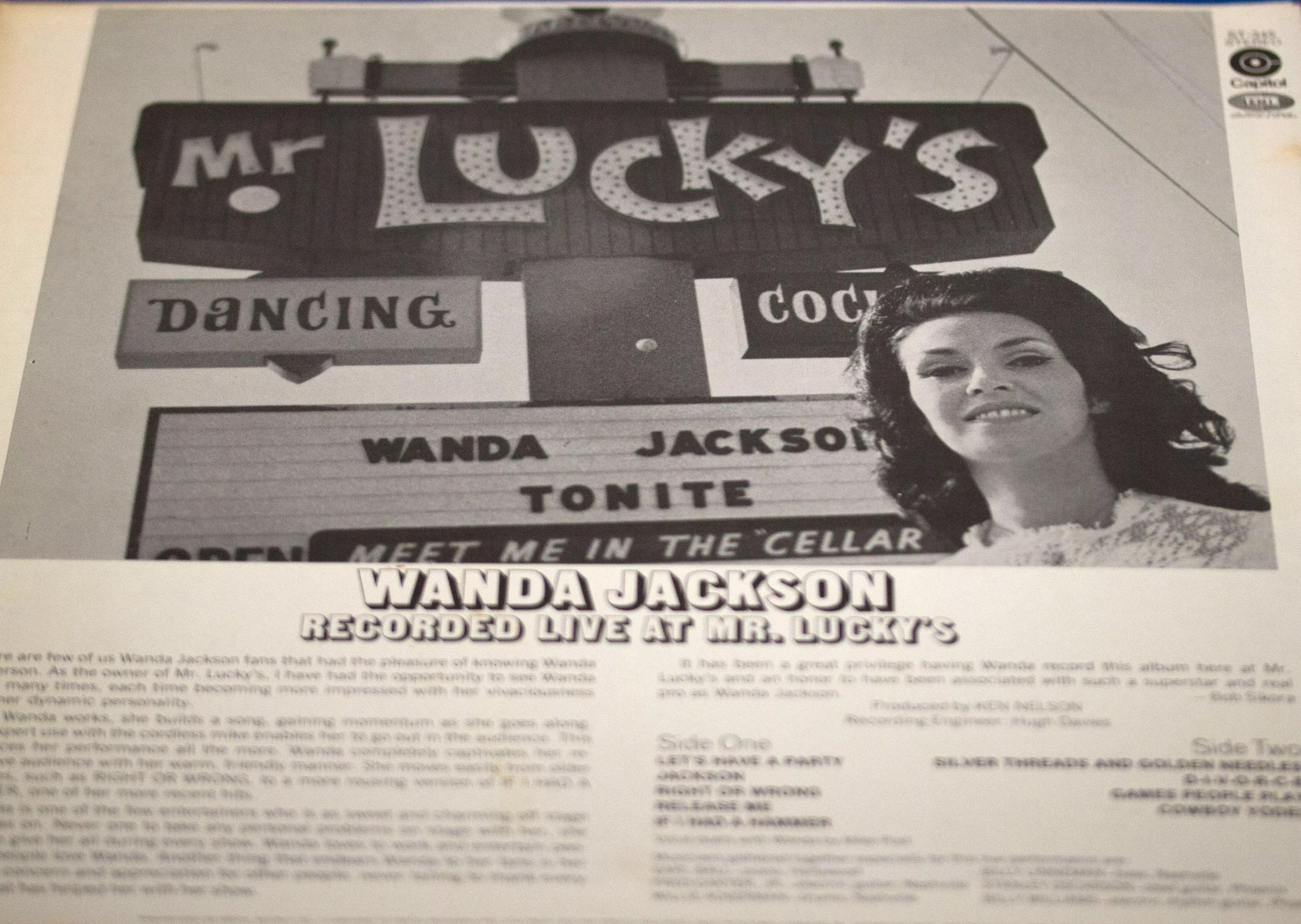
The cover of 1969’s Wanda Jackson in Person.
Tom Carlson
Dixon: All these touring acts came through and played there. Wanda Jackson recorded an album [Wanda Jackson in Person] there in ’69. So it was very high-profile for being a good, well-run club.
Sikora: Glen Campbell played for me at Magoo’s when he was just a recording star in California and hadn’t hit the road yet. I had him back at Mr. Lucky’s a number of times. When Willie Nelson played there when he just wore a suit and tie and didn’t have long hair back in that time.
Ray Herndon, singer, guitarist, and co-owner of Handlebar J in Scottsdale: Everybody that was anybody starting out in the early ’70s came through Mr. Lucky’s and played on guest star night: Ronnie Milsap, Johnny Paycheck, you name it.
J. David Sloan, country musician and former owner of Mr. Lucky’s: I worked for a firm in Nashville building apartments all over the country. [In 1972,] they asked if I wanted to work out here. I thought I was through with music so I said, “Sure.” Waylon [Jennings] and I knew each other. We’d had the same managers. So he kept calling Bob saying, “This guy’s out there swinging hammers; you need to get him in your club.” One night, Waylon called and said, “I’m going to Mr. Lucky’s. Why don’t you come down?” I sat in with these four fantastic musicians and [guitarist] Billy Williams was the bandleader. Afterward, Mr. Lucky’s manager [Don “Bunky” LeGate] told me, “You’ve got a job if you want it.” I told him I had one already. That lasted three days, then I told him I was in.
Sikora: J. David is a great guy. Great singer. Didn’t drink. Didn’t smoke. Didn’t run around. He worked off nights and did so well, Bunky said, “We should bring him in on weekends also.”
Sloan: When I went to work at Mr. Lucky’s, The Rogues had two featured singers. They let one go and offered me his job. I worked with the other singer for a year and a half until they let him go. Then it became J. David Sloan and The Rogues.
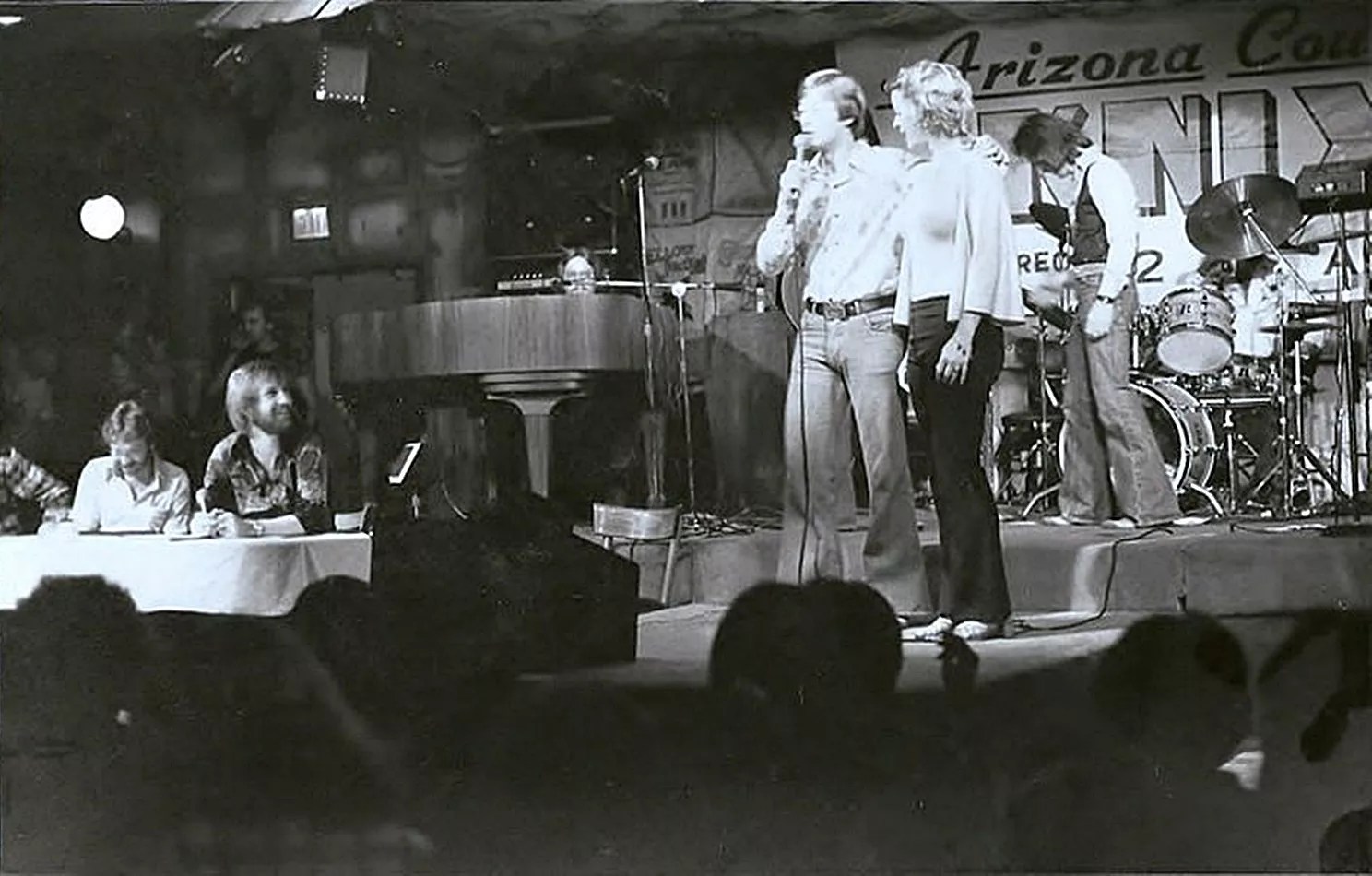
A KNIX-sponsored event at Mr. Lucky’s in the early ’80s.
Courtesy of Jim West
In the mid-’70s, Mr. Lucky’s began two long-running Friday evening traditions: an all-you-can-eat fish fry and a “kids’ night” talent show.
Herndon: The fish fry was very popular. It was inexpensive for back then, some ridiculous price like $2.95. People would always bring their kids out and J. David started getting them up to sing.
Sloan: Tom T. Hall had this kids’ song, “Sneaky Snake,” out on the radio, and I thought I’d learn it because the kids at the fish fry would like singing it. I didn’t have the band, I just sat with an acoustic guitar on the steps. There were like eight kids at first, and I started giving out silver dollars. All of a sudden, it started growing, so silver dollars became Tootsie Pops. It got bigger and we’d started running eight-week contests and picking three winners.
Steve Wood, former on-air talent, KNIX and KMLE: I was hired right out of high school at KNIX by [then-station owner] Buck Owens and [then-program director] Larry Daniels in September of ’79. One of the first clubs I ever got experience at was Mr. Lucky’s. We’d do KNIX nights and they’d always be big. We’d get up and do silly little stage games, be on the microphone, or hand out bumper stickers.
Country music exploded in popularity in 1980 following the release of the romance/drama film Urban Cowboy. Nightclubs like Mr. Lucky’s saw a major boost.
Wood: Country music always had its hardcore base, but something magical happened after that movie came out. Crowds doubled, tripled overnight at Mr. Lucky’s.
West: People bought into it. They wanted to be part of country music and what was happening at Mr. Lucky’s. There were times over the years, especially on weekends, when you could barely move in the club. It was so busy. I distinctly remember trying to get to the bathroom one night and beelining through people. It was just wall-to-wall-to-wall people. Every table was busy, every inch of the dance floor was filled.
Herndon: Urban Cowboy revived everything from the ’60s. When it came along, all that stuff from Charlie Daniels to Mickey Gilley and Johnny Lee sort of sparked that big movement of the dancing scene and the whole thing.
Wood: I’ve got three adult kids and I’ve told them, “If you really want to know what Mr. Lucky’s and country music was like then, watch Urban Cowboy. It captured everything about us. How we wore our hair, how we dressed, like those the feather bands around our hats, and what we were listening to.”
Mr. Lucky’s star rose even higher after it was showcased on Waylon Jennings’ ABC television special, which aired on October 23, 1980. It featured the late outlaw country artist performing for a packed house at Mr. Lucky’s.
Sloan: We had, I think, 1,200 people in there. We got up and performed only one set and then Waylon came out and did his show as they filmed him.
The early-’80s country boom also brought competition. In May 1981, Texas-based nightclub chain Graham Central Station opened a 33,000-square-foot location at 33rd Avenue and Indian School Road. Four months later, Toolies Country opened at Thomas Road and 43rd Avenue.
Sikora: Graham Central Station comes just down the street and they were the first to discount liquor. At that time, they hurt me somewhat because of that. Because I never did that and they did deep discounting, which wasn’t good at all for the town.
Wayne Craig, local promoter and former Mr. Lucky’s employee: I got a job there working the door and some security downstairs. When Graham’s opened, a lot of guys left to go there because they offered a dollar more an hour. But I worked at both places for a while since Mr. Lucky’s would match that. It was like the Hatfield’s and the McCoy’s sometimes. “Why are you still working there?” Why the hell not? You’re making $4.25 an hour back then, it was a big deal. Patrons I knew were very loyal at first. It was either Lucky’s or Graham’s. Not many people went back and forth, but gradually that changed later in the ’80s and ’90s.
W. Steven Martin, former on-air talent, KNIX: I did events at Toolies Country, and half the time the artists would get offstage, tell everyone they’re going back to the hotel, and then go, “C’mon, W., take me to Mr. Lucky’s.” It became the place everyone wanted to be.
Buster Metzger, Mr. Lucky’s regular: You’d go to Mr. Lucky’s on a Tuesday or Wednesday when you couldn’t afford tickets to see a country star in town, pay the $5 cover, and stay for after-hours because whoever was playing Phoenix likely would come by after their concert and get onstage with the house band. You had a better than 50-50 chance they were showing up. I saw Barbara Mandrel and Marty Robbins play after their shows.
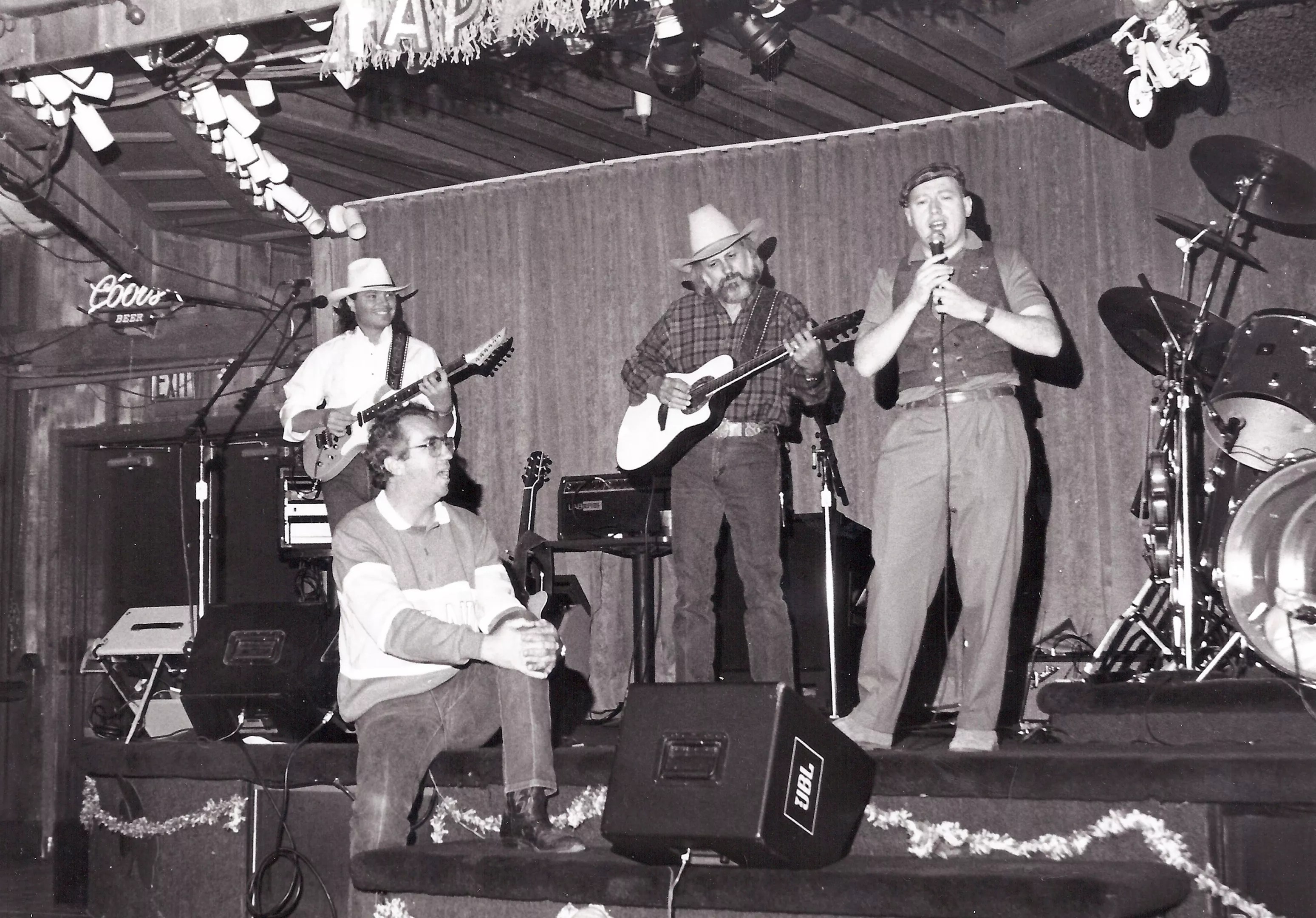
J. David Sloan (center) and The Rogues perform with Irisn entertainer Charlie McGettigan (right) during a St. Patrick’s in the mid-’80s. Then-KNIX on-air personality W. Steven Martin is seated onstage.
Courtesy of W. Steven Martin
After its appearance on national television, an ever-increasing number of folks were coming through Mr. Lucky’s double doors, including patrons and superstars looking to party. The music industry also repeatedly came calling.
Sloan: One feature of Mr. Lucky’s that was pretty important was all these record labels who wanted to bring their new acts in there. One night, the [club’s] manager Steve Natalie came up and says, “I just got a call from an agent and they’re bringing a new band they’re promoting that just signed with RCA Victor. They’re going to play for nothing.” I asked, “Who are they?” He says, “They’re called Alabama.” I’d never heard of them.
Martin: They had a couple of songs out, but nothing that caught fire yet. And we get there the night of the show and [lead singer] Randy Owen is nervous, since this was their big chance. And only half the club was full. So they got up and man, they played their hearts out. They were absolutely fantastic, even back then.
Metzger: Every Friday night and Saturday night, the same people were there. Everyone had one thing in common, they loved to dance and have a few drinks. The rock ‘n’ roll people kept to themselves downstairs and didn’t come up too much and the cowboys didn’t go downstairs.
In 1982, The Rogues added three new musicians – Ray Herndon, Matt McKenzie, and Matt Rollings – creating the band’s most popular lineup.
Herndon: I started playing Mr. Lucky’s in 1982 on my off nights from Handlebar J. Then I started sitting in with The Rogues. And they hired me as a frontman beside J. David. My friend Matt McKenzie is a bass player, and the two of us were at Mesa Community College, which was predominantly a jazz school. He’d go to Mr. Lucky’s and started sitting in with The Rogues. They needed a bass player and they hired him. And he brought in Matt Rollings.
Matt Rollings, composer, keyboardist, and record producer: I attended Phoenix Country Day School, which had an extracurricular Horizon Program for two weeks every spring. One option was shadowing a professional in a field they wanted to pursue. I asked if I could shadow [MCC’s Jazz Program]. I met a lot of student musicians, including Matt McKenzie. My junior year, Matt called, saying “I’ve got this gig at this place Mr. Lucky’s and we need a new piano player.” What he didn’t tell me was that Mr. Lucky’s was the largest honky-tonk in Phoenix playing modern country. So, I went down and auditioned and I showed up as my little preppy, private school self.
Herndon: He was this prodigy in Young Sounds, this musicians union thing for kids to play jazz, and he was incredible. He sat in, and all these veteran guys like Billy Williams, we were looking at each other like, “God, this kid’s amazing.”
Rollings: I was 17 and wasn’t legally allowed to be in the club proper, but I could be back in the band room when I wasn’t playing.
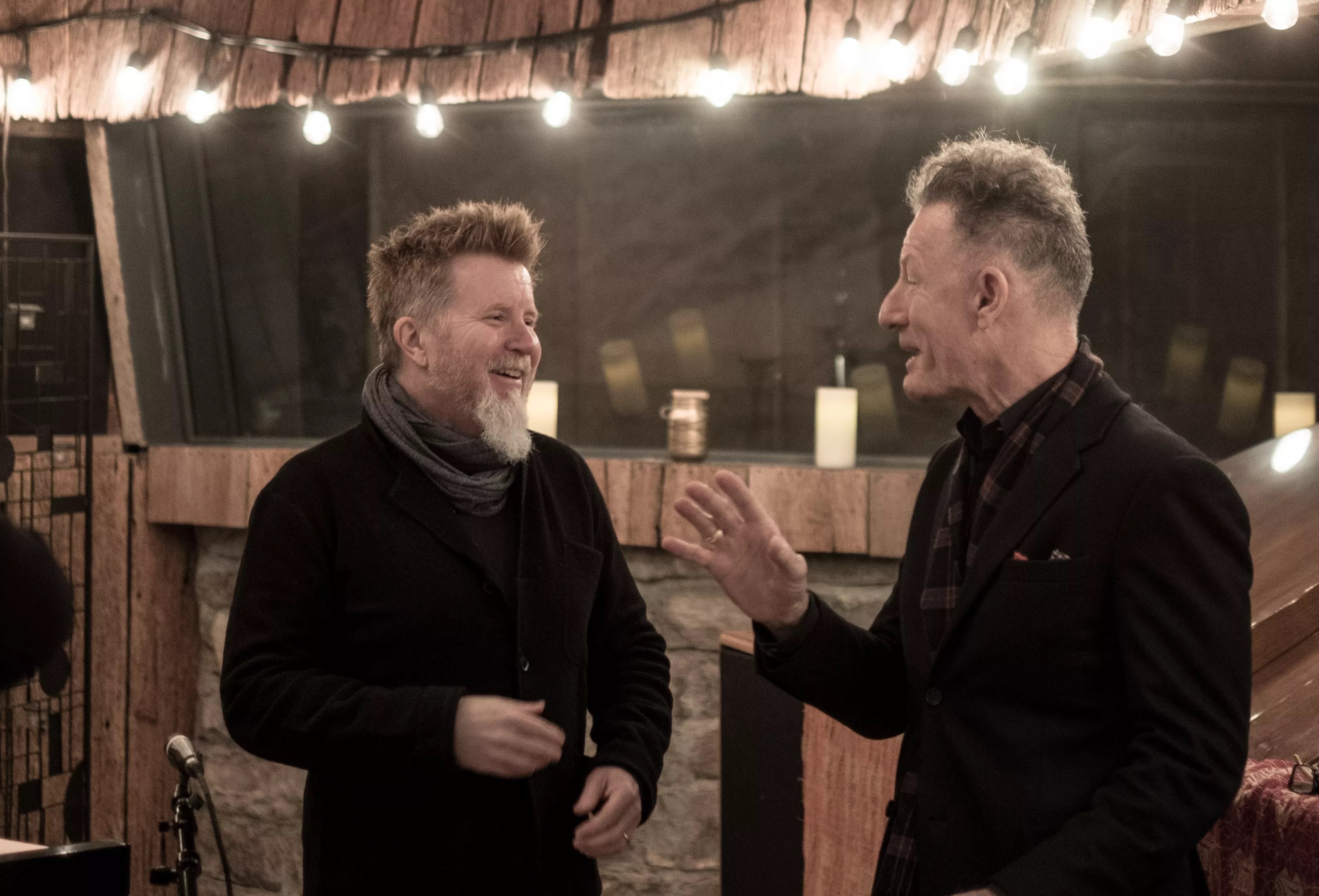
Keyboardist/pianist Matt Rollings (left), a former member of Mr. Lucky’s house band The Rogues, with country star Lyle Lovett, who visited the nightclub in the early ’80s.
Michael Wilson
In 1983, The Rogues had a month-long stint in Luxembourg, where they crossed paths with a then-unknown Lyle Lovett.Sloan: When we got over there, the promoter said, “There’s a young songwriter from Texas I want you to give him 15 minutes in each of your sets.” I asked what his name was, and it was Lyle Lovett. He was a solo act and had never worked with a band before. So I said, “I need to hear his stuff.” And when I heard it, I knew the band would love it.
Herndon: We were at this fair, and Lyle was sandwiched between our band and a Las Vegas show band. He was playing his own music and getting lost in the shuffle. Either J. David or Billy said, “Why don’t you play with us? We’ll learn some of your songs.”
Rollings: He came back to Phoenix and recorded 18 songs with us, with Billy Williams producing at Chaton Studios [in Scottsdale] and our band playing.
Sloan: He was living with Billy and came out to Mr. Lucky’s during the week and weekends and we’d get him up and have him perform.
Herndon: Lyle took that stuff and ran with it. Went to Nashville, got signed by MCA Records, and the rest is history. Matt McKenzie played on several of [his records] early on. Matt Rollings and I have toured, somewhat off and on, with Lyle ever since.
Sloan: Matt McKenzie’s worked for Patty Loveless and all kinds of big-name acts. Matt Rollings now produces Willie Nelson.
Rollings and Herndon both left The Rogues over the next few years. In 1987, Sloan followed suit and moved to Nashville.
Sloan: Waylon had called me and said, “Hey, there’s a bunch of songwriters with a bunch of good [material] looking for a singer. Why don’t you come back here? Maybe something will finally happen for you.” So I thought, “Let’s do it.”
A year later, Sikora rang him with a different offer: He wanted Sloan to buy Mr. Lucky’s so he could concentrate on Bobby McGee’s, the chain of restaurants and bars he’d launched in 1971 that had expanded to 24 locations by 1988.
Sikora: I was too busy with Bobby McGee’s and growing it and didn’t have the time to spend getting guest stars [into Mr. Lucky’s] and operating it correctly. J. David is who I picked to sell it to.
Sloan: He called me up and said, “I need to sell this. If you come back, you can own it.” I told him, “Hell, Bob, I worked for you for 15 years. I don’t have money.” He said we’d figure out a price and I could pay it out over a few years. So we made a deal.
In 1990, The Rogues dissolved after Billy Williams stepped away from the group, ending their 24-year stint as Mr. Lucky’s house band.
Sloan: Billy was doing a lot of work with Lyle, so he wanted to retire [from The Rogues]. And that’s when I hired a young band called Western Bred. They worked there the remainder of the 14 years.
The following year, Sloan built a large rodeo arena outside the club. It became one of its most popular attractions.
Sloan: A couple of bull contractors from Alamogordo, New Mexico, came into the club. They bought bulls, bucking bulls, to send to rodeos and wherever. They were aware of Billy Bob’s, the big nightclub in Texas with a rodeo arena inside the club. These guys said, “You ever thought about putting in a rodeo arena?” and convinced me it would really help the business.
Jaylon Kretchmar, audio engineer, J. David Sloan’s son: There were no other bars in town that had live bull-riding then.
Sandy Mackulin, former Mr. Lucky’s regular: J. David had it cordoned off where they had the over-21 section and bleachers out in the parking lot so the under-21s could go outside and watch it. There was always a packed house. Wednesday nights, they could have, like, 15 riders, but on Fridays and Saturdays, it could be as much as 40 or 50. We had world champion bull-riders, like Cody Custer from Wickenburg, come by to judge. It was good, wholesome fun you could bring your kids to.
Kretchmar: It was a place where a lot of the guys cut their teeth and became major players. Wayne Brooks, who’s one of the top announcers in the country, started out at Mr. Lucky’s. A lot of guys who started doing bull riding in our arena ended up in the National Finals Rodeo, like [Don] “Hollywood” Yates.
Mike Broomhead, KTAR talk show host: I moved to Arizona in 1995 because I had come here on vacation and I wanted to be a rodeo cowboy. I started hanging out at Mr. Lucky’s and learned to ride bulls. I had a regular job, but on Friday and Saturday nights, I started getting on practice bulls and novice bulls. And I ended up announcing the bull-riding from about ’96 until about 2001.
Kretchmar: I have people that hear about it now and think either it was fake, or we had one bull that people would go out and ride. They wouldn’t realize there’s a trailer full of stock brought in every night. Or they’d think people would just get drunk and go get on a bull and be kind of crazy. Neither was the case whatsoever. If we ever suspected anybody of drinking at a time, we wouldn’t let them ride.
Broomhead: Those were the guys who were really true rodeo cowboys that were going out there competing. There were a lot of really, really good bull riders and pros that were out there. So it wasn’t a novelty. It was something that these guys really took seriously.
In 2000, future American Idol winner Jordin Sparks began competing in Mr. Lucky’s kids’ night talent contests. Sloan and Kretchmar also helped prep her for future superstardom.
Kretchmar: She just blew the crowds away. Anytime kids saw Jordin was on the sign-ups list, they’d get bummed out because they knew they didn’t have a chance of winning. We coached her through how to do a recording. Then Dad [Sloan] worked with her on singing live with the band, and recorded some of her first stuff.
In 2003, Keith Urban filmed a performance at the club for the music video for his song, “Who Wouldn’t Want to Be Me,” and an alumnus of The Rogues helped make it happen.
Kretchmar: I got a call from Keith Urban’s road manager, and he’s like, “Hey man, do you mind if we come out there and shoot a video?” They were going to be in town for a concert and Keith had heard a lot about Mr. Lucky’s, because Matt [Rollings] produced his first album.
Mackulin: We were all surprised he was going to be shooting a music video there. This guy who’s a national artist with No. 1 hits out the wazoo and a sold-out show in town is coming to the bar you hang out at six nights a week.
Kretchmar: He announced at the concert he was going out to Mr. Lucky’s afterward to party. So you couldn’t get in that place at all. It was just jam-packed. Keith Urban played for two hours while they shot it. The whole second half of the video is from Mr. Lucky’s.
The party at Mr. Lucky’s couldn’t last forever. Stricter DUI laws, declining crowds, and the shifting demographics of the neighborhood took their toll on the club’s bottom line by the early 2000s. Sloan tried stopping the bleeding. In December 2003, he shut down the rodeo arena after it became a financial drain. Latin dance and old-school hip-hop nights took over the basement. In June 2004, he closed for a month to remodel the club.
Kretchmar: In the early 2000s, the housing market [boom] hit and they threw mortgages at people left and right. Everybody started buying houses in the outskirts of metro Phoenix. And DUI laws got tougher, so people weren’t willing to risk driving to the center of town when they could go to a bar in their neighborhood. It became a thing where [Mr. Lucky’s] was only going to be good for people living nearby, but the neighborhood’s demographics changed to Hispanic and wasn’t necessarily country or rock clientele.
Sloan: Business wasn’t as good as it should’ve been. We still had our heads above water, but after all those years of being there, I was getting kind of tired.
In August 2004, Sloan announced he was closing Mr. Lucky’s after 36 years and leased the property to local businessman Brian Weymouth and other investors behind the now-defunct Alice Cooper’stown.
Sloan: These guys made me an offer and I was ready. They didn’t want to buy the property. They leased the building and everything in it from me. So it was a good deal. I could relax after all these years. I think if business had really stayed up, I might have considered staying.
Kretchmar: It’s a lot of work running a club. The music and the people is the fun part of it, which is what everybody remembers. But the bar business part of it? That sometimes stunk. And there aren’t many musicians who have a retirement plan. So when the opportunity came for him to be able to retire from the bar and focus on music, it was like, “Yeah, no-brainer.”
Herndon: I had moved to Nashville by the time Mr. Lucky’s closed, but kept in touch. When J. David walked away from it, I can tell you he was ecstatic about it. He was ready to get out.
Mackulin: We were all really sad to see Mr. Lucky’s go since it was such a big part of our lives, but I was happy for J. David. It was the end of an era.
Years later, Sloan sold the property. It had become a Latin nightspot that kept the Mr. Lucky’s name and sign. The Great Recession forced the property into foreclosure in 2009, and it was scooped up by California businessman Vahak Minassian the following year.
Kretchmar: As a Hispanic club, Mr. Lucky’s became very popular for [Latin] music, too, until the crash came in 2008, and then everything went downhill, and not just for them.
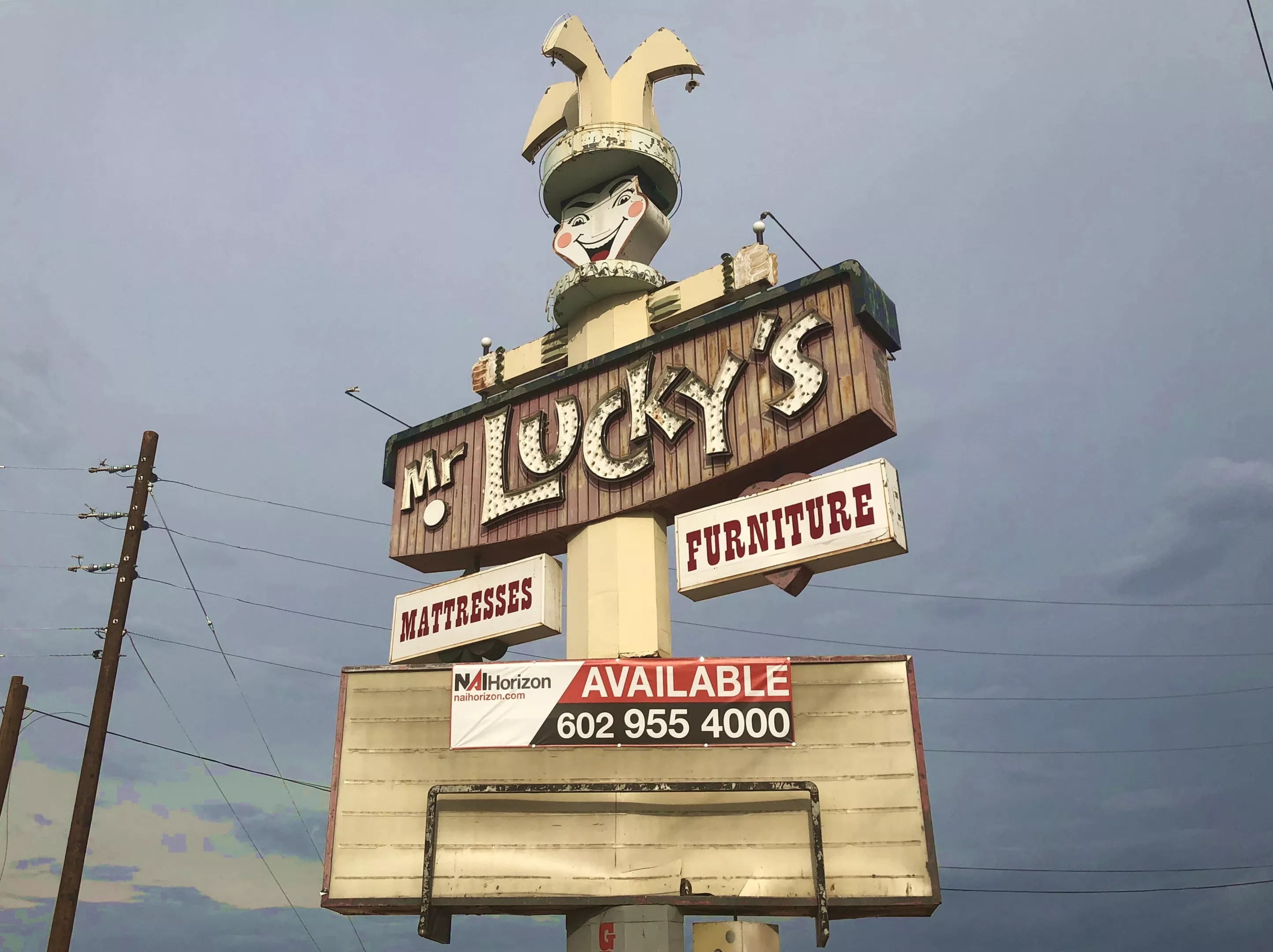
The current state of Mr. Lucky’s sign.
Benjamin Leatherman
In 2012, Sloan and Herndon launched the “Back to Mr. Lucky’s” night at Handlebar J in Scottsdale. It became a reunion for the bygone nightclub’s former regulars who missed their old stomping grounds.
Herndon: I’d moved back to town and J. David came to Handlebar J one night to sit in with our band. I told him, “We got to do something together again. It’s been a long time. Why don’t you come back and do a whole night?”
Sloan: I said, “Let’s plan it and really advertise it.” It was so much fun with the nine-piece band like we had [at Mr. Lucky’s] with the horn section and everything.
Kretchmar: We also gave the guys at Handlebar the original fish fry recipe. People were able to see J. David and see the Herndon Brothers, which has some of the guys from The Rogues, and get that familiar taste they used to have all the time. It’s kind of like a little reunion.
A series of different businesses have since launched at the Mr. Lucky’s property. Some use its name. None have lasted. By 2013, it had become a banquet hall and events venue. In 2016, a furniture store moved in, followed by a restaurant called Mr. Lucky’s Grubhouse in 2017.
Craig: That neighborhood has never liked anything [that’s gone into] Mr. Lucky’s. People have tried putting other things in there and all the neighbors still fight it.
Sloan: It’s sad to drive by there and see it, because we always kept the place up, kept the building painted, and kept the sign up.
Mr. Lucky’s property was auctioned off in July via an online commercial real estate exchange, though the deal with the winning bidder failed to close. (An agent with real estate broker NAI Horizon, which is handling the property, says it may have been due to a funding issue.) A second auction is scheduled for November 15 to 17.
Craig: Some people and myself were [bidding] on it together, but the price just got too high. We really wanted to do something big with it. But we didn’t have enough money. Hopefully, whoever buys it will save that sign.
Sloan: That’s all people even talk about anymore. I mean, people come up to me and say, “We see the sign is still there. Why don’t you take that with you?”
Kretchmar: People think we still have access to it. It’s not ours anymore.
Sloan: If you take that sign down, you’ll never put it back up anywhere. It won’t be allowed. It’s too tall.
Kretchmar: It’s grandfathered in through the [current municipal] sign laws. It’ll never go anywhere else, which is a shame, because I wish somebody would restore it because it looks terrible right now.
Marshall Shore, local historian and Arizona Vintage Sign Coalition member: Its marquee and paint are a mess. Little by little, it’s been cannibalized and gotten worse and worse. It’s a real shame since the sign is a Valley treasure and the club has such a history and legacy.
Kretchmar: People still talk about [Mr. Lucky’s] to this day. That’s why we’ve done these reunion parties, because it feels like people still want to remember the magic. And for us, we can go to these things, see a bunch of old friends and family, and just enjoy the music and we don’t have to run the business. So it’s fun for us.
Sloan: I don’t know what I’d have done with my whole life if I hadn’t had Mr. Lucky’s. I feel very blessed to have been there for 32 years. So it’s kind of a lifetime.
Editor’s note: Some quotes have been edited or condensed for clarity.